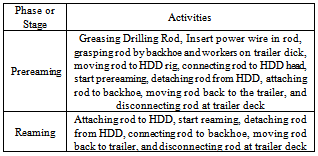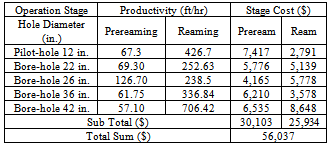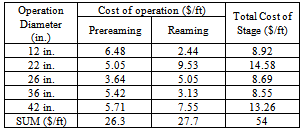-
Paper Information
- Next Paper
- Paper Submission
-
Journal Information
- About This Journal
- Editorial Board
- Current Issue
- Archive
- Author Guidelines
- Contact Us
International Journal of Construction Engineering and Management
p-ISSN: 2326-1080 e-ISSN: 2326-1102
2013; 2(3): 46-52
doi:10.5923/j.ijcem.20130203.02
Cyclic Productivity for Horizontal Directional Drilling (HDD) Operation
Mohmd Sarireh
Department of Civil Engineering, Tafila Technical University, P.O. Box 179, Tafila 66110, Jordan
Correspondence to: Mohmd Sarireh, Department of Civil Engineering, Tafila Technical University, P.O. Box 179, Tafila 66110, Jordan.
| Email: |  |
Copyright © 2012 Scientific & Academic Publishing. All Rights Reserved.
Horizontal directional drilling (HDD) is considered as the most applicable and cost effective technology among trenchless technologies known. HDD can be applied in different soil conditions, for deep laying of different pipeline diameter and long drives. From 12 HDD units manufactured in 1984, about 32,135 units were manufactured and sold in 2011. Studying HDD productivity is the first goal of this case study. Using cyclic nature of operation, HDD productivity can be determined by applying MicroCYCLONE simulation. Also, operational cost of project can be estimated. Through the current research, presenting of HDD resources is another goal that was achieved in terms of human and mechanical resources.
Keywords: Horizontal Directional Drilling, HDD, Trenchless Technology, TT, MicroCYCLONE, Productivity, Pipeline Construction
Cite this paper: Mohmd Sarireh, Cyclic Productivity for Horizontal Directional Drilling (HDD) Operation, International Journal of Construction Engineering and Management , Vol. 2 No. 3, 2013, pp. 46-52. doi: 10.5923/j.ijcem.20130203.02.
Article Outline
1. Introduction
- Horizontal Directional Drilling (HDD) technique has achieved a great growth in installation of underground pipelines and conduits. HDD was originated from oil fields industry in the 1970s and was developed by emerging technologies to be used in utilities and water well industries. A 12 HDD operational units were manufactured in 1984 compared to a 2,000 HDD operational units in 1995[1]. Approximately, 17,800 HDD unites were manufactured and sold during the period between 1992 and 2001 in North America[2]. The number of HDD rigs manufactured worldwide recently comes to 32,135 units in 2011, with 80% of these rigs manufactured in USA[3]. Among trenchless technologies, HDD has a good standing applicability in most of underground applications[4]. HDD has about 15% as applied uses for installation of water, gas distribution, oil/gas transmission, telecommunications, and electric, except for sewer it has the minimum applied uses of 12%[5]. HDD operation is considered cyclic in nature. The operation mostly consists of three stages; pilot bore-hole is accomplished using a drilling head (usually 4 to 6 in.), reaming (enlarging) of bore-hole using larger reamer, and finally pullback of product pipe through bore-hole using larger reamer or a swapper (closed cylindrical barrel) or both depending on soil type. Figure 1 illustrates stages of HDD operation.
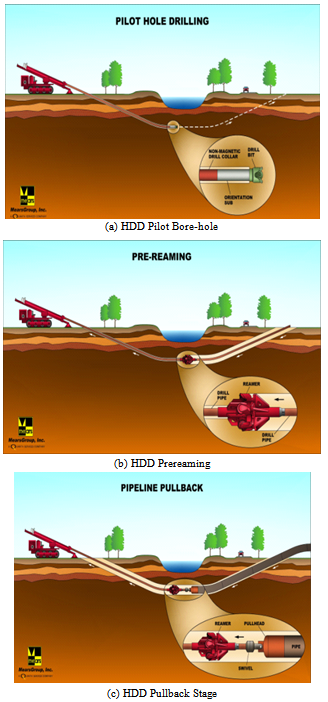 | Figure 1. Stages of HDD Project[6] |
1.1. MicroCYCLONE Programming
- The idea of queuing was developed in MicroCYCLONE by Halpin in 1973 for modelling repetitive and sequential construction operations. Underground construction using trenchless technologies including HDD, are some examples on repetitive underground operations. Simulation of such operations can help in developing different scenarios using sensitivity analysis[7].Similar to MicroCYCLONE, SLAM II byGonzalez-Quevedo was introduced to simulate activities, resources, and modes of construction operations[8]. Also, simulation of resource change, resource conflict, and delay using Cell-DEVS method for replacing sections and panels of main span of the bridge was introduced as an example of sensitivity analysis of resources[9]. The problem in HDD projects that the productivity of operation is changeable depending on soil conditions encountered, and project parameters (length and diameter of bore-hole). Also, HDD productivity can be different in one project. So, getting benefit of repeating cycles of operation, cyclic operation such as HDD can be simulated on time required for production unit (32 ft drilling rod) to be drilled or reamed using MicroCYCLONE program.MicroCYCLONE program can be written in a specific screen by defining the general statement by the project name and length of run for time units and number of cycles for operation (resource gain-learning tool), and then by adding input durations which are: combi that has more than two resources (as constraints) and at least two queues of activities contribute in combi activity, then normal activity that continues without any conditions or constraints. Figure 2 illustrates MicroCYCLONE activities and functions. Activity type (normal, combi, and queue) is shown in the figure. Also, direction of network (arrow), function (counting of cycles and unit of production), and accumulator for accumulating partial units into the main production unit are parts of the program.
 | Figure 2. MicroCYCLONE Activities Architect |
1.1.1. MicroCYCLONE Duration Input
- Each activity should have duration that usually follows a specific statistical distribution (MicroCYCLONE uses continuous distributions). The applicable distributions that are utilized in MicroCYCLONE include: constant (deterministic), exponential, uniform, normal, triangular, lognormal, and beta. These distributions are described by statistical parameters such as minimum and maximum value, mean, mode, in addition to shape parameters in some cases.
1.1.2. MicroCYCLONE Application in Construction
- MicroCYCLONE was utilized in installation of pile foundation considering the complicity of operation[10] and[11]. Simulation was considered to evaluate productivity and cycle time for overall operation and inner tasks. MicroCYCLONE version 2.7 developed by Daniel W. Halpin 1990-1992 was selected to simulate the piling operation[12]. Data for activity durations was collected as minimum duration, maximum duration, and most probable time respectively. The outcome of simulation was the productivity of piling operation (hole/hour) for a classified category of pile conditions including pile size, technique, pile depth, and soil type.Productivity of pipe installation using micro-tunneling was studied by utilizing MicroCYCLONE simulation to obtain cost of operation[13].
1.2. Hdd Productivity
- HDD was investigated and studied as part of a wider study including known trenchless technologies. It was concluded that HDD may be more suitable for some problematic soil conditions than other TT methods[14].Similar to other trenchless technologies, HDD has many advantages in comparison to conventional open-cut construction. HDD has minimal impact in congested urban or suburban areas, less restoration cost of sidewalks, pavements, vegetation, and other surface features. The reduced disruption in business-related traffic flow and commercial activities usually associated with open-cut methods is a major advantage for HDD[15]. Furthermore, the minimum need for soil support at entry and exit pits and the minimal required space in comparison to other trenchless applications is a particular advantage of HDD.HDD productivity was studied considering two case studies of projects in sandy soils[16]. The first installation was a 1.6-in. diameter polyethylene pipe for a distance of 880-ft, and the second installation was a 2.36-in. diameter HDPE pipe. A linear regression model between time and bore length, resulted in a productivity rate of 123.4 ft/hr and 88.4 ft/hr, respectively. As anticipated, HDD productivity is likely to be degraded in sandy soil when it contains gravel or cobbles. While it may also be anticipated that productivity would decrease with increasing pipe diameter.Also, HDD productivity was investigated considering company profile, type of project, duration, product pipe, bidding and estimating practices, and planning and operation control in soil conditions encountered[1] and in[17] considering product pipe material, size, and applications. Similarly, HDD productivity rates (ft/hr) in clayey, rocky, and sandy soils were collected for HDD projects[18], and results are represented in Table 1.
|
2. HDD Pilot Project
- A HDD pilot project was selected to collect real live data about HDD operation. Data collection began with site visits to the project during preparation, initial (pilot) borehole drilling, prereaming and reaming, and pullback of the product pipe. Data collected for HDD productivity defined as the time in minutes required to continue drilling of 1-drilling rod distance of 32 ft during pilot bore-hole, prereaming and reaming, and pullback of product pipe. The project was located at Highway 360 at Trinity Boulevard, Fort Worth, TX, USA, Figure 3 illustrates HDD project crossing Highway 360.A 30-inch diameter steel pipe was placed beneath the highway, for a distance of 1,100 ft, to host a 26-inch diameter ductile iron product pipe intended to convey reclaimed water. This particular site and application was selected as appropriate for obtaining accurate real-world data, to determine productivity and cost of HDD operation. Soil condition is almost clay, but it changes from hard clay (shale) to sandy clay and silty clay as shown in Figure 4.In current research, productivity data will be analysed and represented, with emphasis on pilot bore-hole, prereaming and reaming stage, and pullback which is typically the most time intensive phase of the overall HDD operation.
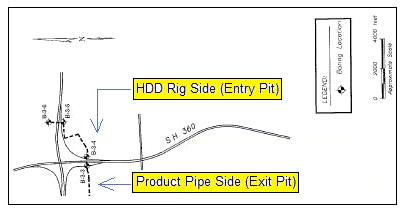 | Figure 3. HDD Pilot Project Site Layout[6] |
 | Figure 4. Bore-path Profile for HDD Pilot Project[6] |
2.1. HDD Pilot Project Data
- Data were collected for durations (time in minutes) of the activities included in prereaming and reaming stage in the project selected as pilot project. Table 2 represents activities covered in both phases. Data included drilling of pilot borehole of 12 in., reaming and prereaming using 22, 26, 36, and 42 in. reamer. 28 to 34 of data points were collected for each stage (minor activities or tasks) through attending drilling operation during site visits to the project.
|
2.2. MicroCYCLONE Plan for HDD Pilot Project
- Drawing the plan of operation and writing down the Program are the first two steps in MicroCYCLONE Simulation. Usually, the plan includes the resources and their status between working and queuing. Figure 5 illustrates the sketch plan of HDD operation.The preream of pilot bore-hole is composed of the following activities:1- First, the drilling rod (32 ft length, an 8 in. outside diameter) is in queuing state at trailer deck beside HDD rig (for Midi- and Maxi-HDD) or in a basket on HDD rig (for Mini-HDD). Other resources that are in queuing include trailer, trailer operator, two workers on trailer deck, HDD rig, operator, and worker, backhoe, loader, and two operators for both.2- Greasing drilling rod at both ends by trailer’s workers.3- Inserting of power wire (for tracking system) by trailer’s workers.4- Connecting rod to Backhoe on trailer deck by workers.5- Moving rod to HDD rig by backhoe.6- Connecting rod into HDD rig by operator and worker.7- Prereaming or drilling a rod distance for 32 ft, in this stage the HDD operator receives instructions and directions by the surveyor from the surveying truck or station. Also, recycling and pumping system with two workers are needed in this step.Then, disconnecting HDD rig form the last drilling rod to receive a new one.HDD operation continues by prereaming (enlarging the pilot bore-hole) using larger reamer’s diameter for number of passes depending on final bore-hole diameter required to permit smoothly pullback of product pipe. Figure 6 illustrates the MicroCYCLONE diagram for prereaming operation using HDD under ground motor, the difference in this stage is that HDD operator follows the bore-path of the pilot-hole without receiving any tracking data for length and depth of drilling head.Then the operation is reversed in reaming process, by pushing the reamer back in bore-hole from entry pit toward the exit pit using the underground motor head and drilling fluid to move the spoil out of bore-hole. Figure 7 illustrates the diagram for reaming operation in HDD project.
 | Figure 5. MicroCYCLONE Diagram for Prereaming Pilot bore-hole in HDD Operation |
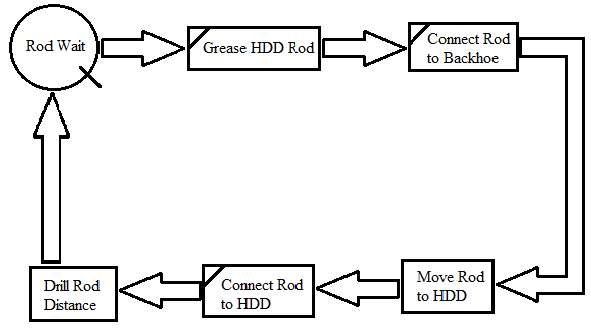 | Figure 6. MicroCYCLONE Diagram for Prereaming Bore-hole in HDD Operation |
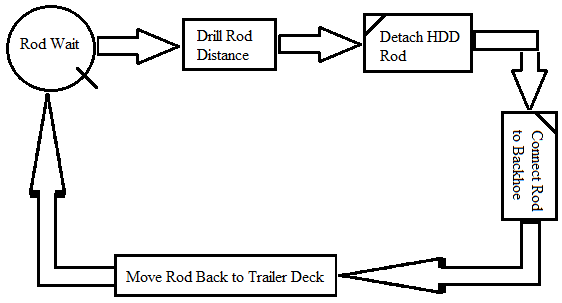 | Figure 7. MicroCYCLONE Diagram for Reaming Bore-hole in HDD Operation |
2.3. Data Durations of MicroCYCLONE Activities
|
2.4. HDD MicroCYCLONE Analysis
- The analysis for the HDD pilot project had been implemented on the following stages of HDD operation:1- Drilling the pilot-hole using a 12in.-diameter reamer in prereaming and reaming stages.2- Prereaming of bore-hole using 22 in. reamer starting from the exit pit to end operation at the entry pit, and then start reaming (pushing back) using the same reamer from the entry pit until reaching the exit pit.3- Prereaming of bore-hole using 26 in. reamer diameter from exit pit to entry pit and reaming (push back).4- Prereaming of bore-hole using 36 in. reamer diameter from exit pit to entry pit and reaming (push back).5- Prereaming of bore-hole using 42 in. reamer diameter from exit pit to entry pit and reaming (push back).It is usual to swap the bore-hole using a swapper (closed cylindrical barrel) with diameter similar to that used in the last prereaming/reaming operation. Usually, the swapper is attached to the reamer in the last stage, which was done in current project.
3. HDD MicroCYCLONE Results
- After drawing the MicroCYCLONE plan, writing the program in the MicroCYCLONE webpage (http://cyclone.ecn.purdue.edu:8080/WebCYCLONE/Cycl one.jsp, April Edition 2005) is the last step to get productivity results. The Following results for HDD productivity and cost were obtained and represented in Table 4. The cost included the operational drilling cost only, not including preparations (detecting of existing services, fencing, excavating of entry and exit pits), not also casing pipe nor product pipe and manholes. Also, represented cost is specific for this project, but it can be used as guidance for other HDD project similar in conditions.
|
|
4. Conclusions
- The current research has focused deeply on productivity of HDD operation in a pilot project to figure out and achieve the following aims:1. Studying and describing of HDD supporting systems (mostly mechanical parts) and human resources.2. HDD productivity (ft/hr) also an important goal of the current research. Productivity for prereaming/reaming of initial pilot bore-hole (12 in.), 22, 26, 36, and 42 in. were estimated. Also, operational cost (operational and owning cost for machine and human resources) for process were estimated.3. Applying MicroCYCLONE simulation in studying productivity and cost of HDD operations or any other trenchless and construction operations is feasible and can be beneficial for construction team (including designer and constructor). Estimated results for productivity and cost can be used to estimate and predict productivity and cost for new projects similar in soil conditions, pipeline depth, length, and diameter. Some costs were not been accessible such as preparation costs, and some material cost such as product pipe cost (cast iron, and ductile iron), welding process, consultant and supervision costs, safety costs, cost of tracking of existing services (power lines, telecommunications, gas pipelines, and water mains and lines), in addition to some materials such as bentonite and polymers used in drilling fluid.
Research Limitations
- The current case study is still helpful, even it has some shortcomings and limitations:1. The main description of soil in pilot project is the clay, but it has sand and silt though the bore-path, and the clay is changed into hard clay (shale).2. The productivity is still specific for these soil conditions which are different.3. The curved path of drilling from entry to exit pits is another factor that can affect productivity in addition to soil type effect.4. Cost of operation is not complete, because contractors do not give total and real cost for operation as they have some conservations on cost for reasons of competency and security.5. It was not able to access project in all times or stages for reason of transportations, safety, or weather conditions. So, it was usual to miss part of operation or section in soil type.
ACKNOWLEDGEMENTS
- The Author would like to direct his thanks for the colleagues and students in Tafila Technical University for saving his time and give support to accomplish this work. Also great thanks for Dollan Directional Drilling Company for their permission to access pilot project site and making reviews, and Alan Plummer Associates for their coordination and help for site visits during operation. Un ending thanks for my family, my wife, and my children for the time they share me working on this research. Thanks for all they help in getting this work out.
 Abstract
Abstract Reference
Reference Full-Text PDF
Full-Text PDF Full-text HTML
Full-text HTML
